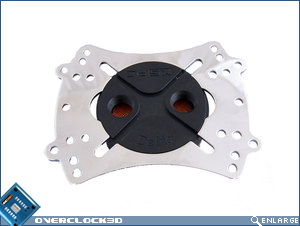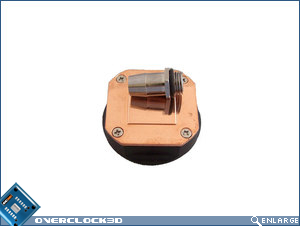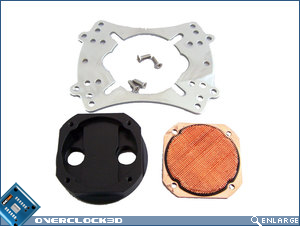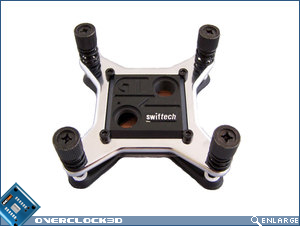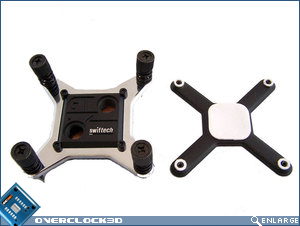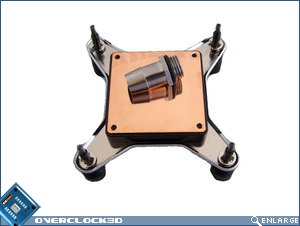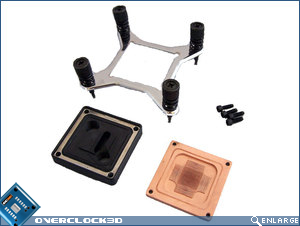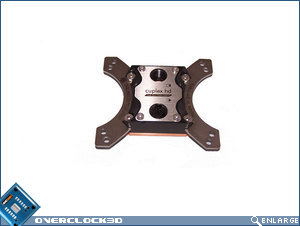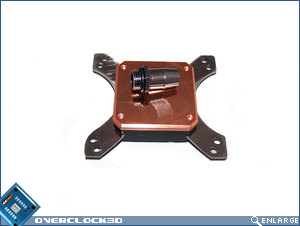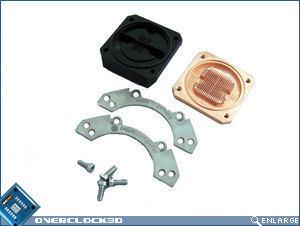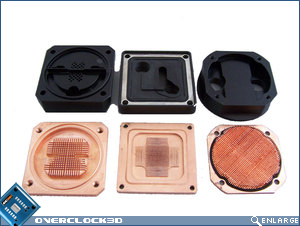Waterblock Shootout
A Closer Look
Â
XSPC Delta V3
Â
There are a few noticeable changes about the XSPC Delta V3 Acetal waterblock that are worthy of further discussion. Firstly, gone is the machined brass all metal top with chrome finish, and it has been replaced with an Acetal one. The Acetal top is machined to accommodate G1/4 barb holes. The ‘X’ for XSPC is still present on the top though, as on the other two versions of the block.
Â
Secondly, the copper base is no longer press fitted to the top, but instead four screws have been implemented to make cleaning of the waterblock easier. The copper base also has a really nice mirror finish to it.
Â
Â
With the XSPC Delta V3 Acetal waterblock pulled apart we can see the pins inside. According to XSPC, the pin count has been increased from around a 1000 to just over 1600 pins. Looking at the underside of the Acetal top we can see that there is a solid piece of Acetal that has been left in the centre. The G1/4 barb hole on the underside of the Acetal top is also machined slightly larger than where the bottom of the barb sits. This is probably more than likely to allow greater coverage of the cooling pins with the coolant.
Â
Â
Swiftech Apogee GTZ
Â
The Swiftech Apogee GTZ is an impressive looking beast. Featuring a screw-on backplate, this will ensure that you’re able to screw the block down nice and firmly against the surface of your processors IHS. Like the XSPC Delta V3 water block, the Swiftech Apogee GTZ features an Acetal top with ‘GTZ’ machined into it.
Â
Â
The copper base of the Swiftech Apogee GTZ is very well lapped, and has an amazing mirror finish. The copper base is attached to the Acetal top via four 3/32″ hex head screws. Once the screws are undone, the Swiftech Apogee GTZ can be seen in its entirety. The copper base features micro-channels to draw heat away from the base and then into the coolant. The micro-channels should allow this waterblock to be extremely efficient when it comes to flow performance.
Â
The underside of the Acetal top features an elongated inlet which should provide additional dispersion of coolant over the micro-channels on the base. The inlet on the underside of the Swiftech Apogee GTZ features a slightly larger surfacing than the barb size, but yet the remainder of the inlet is a little smaller. This feature should force coolant to disperse over a greater surface area of the copper base.
Â
Â
Aqua Computer Cuplex HD
Â
Like I said on the previous page, this block epitomises art, Instead of including an additional hold-down plate like the XSPC Delta V3, the Cuplex HD’s hold-down plate is part of the waterblock itself. Unfortunately, it doesn’t provide the universal compatability of the XSPC Delta V3; instead it is only compatible with Intel Socket 478 and LGA775 platforms. The top of the Cuplex HD is fitted out with G1/4 holes into an Acetal block, and according to the company they are not planning on releasing the waterblock in any other hole-size format. At least in the short term
Â
The Aqua Computer Cuplex HD waterblock’s copper base is very well lapped and free of any visible marks. The mirror finish is quite exceptional. Unfortunately, the sample I received had some deep scuff marks on one leg of the hold-down plate, although this will not affect performance of the waterblock in any way.
Â
Â
The Aqua Computer Cuplex HD waterblock is probably the closest of the three to have utilised an impingement style of cooling.
Â
Â
Let’s head over the page to see how we’re going to test the waterblocks…



